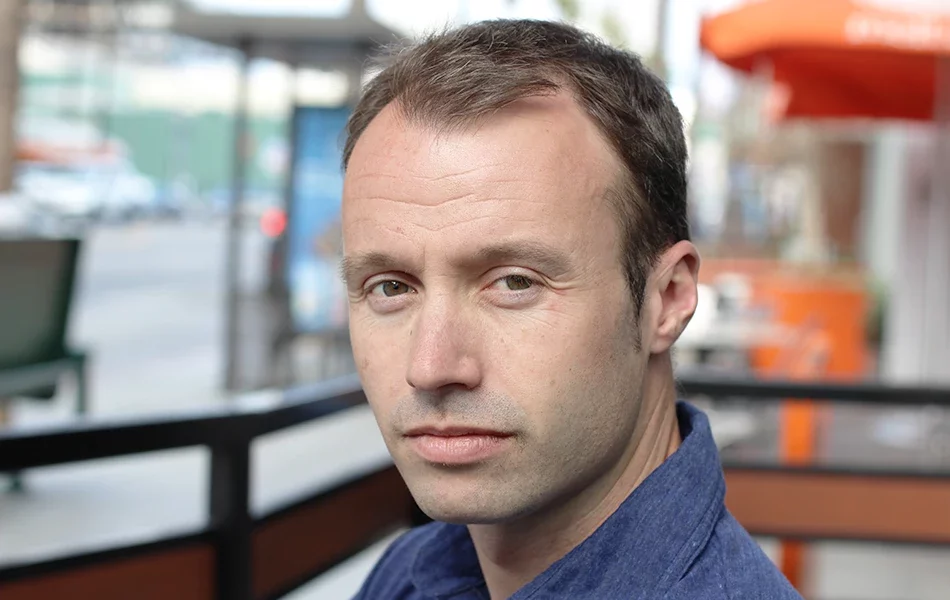Does Testosterone Cause Hair Loss? Uncovering the Truth Behind Baldness
It’s commonly believed that male pattern baldness is caused by fluctuating testosterone levels within the body, but is this actually the case? We explore the link between testosterone and hair loss.

The older we get, the less efficiently our body runs. This can result in longer recovery time from injury, weaker bones, and wrinkles. Another element that aging can affect is the production of hormones that control hair health, including testosterone.
The relationship between the hormone testosterone and male pattern hair loss is often misunderstood. Many people think that going bald is a sign of low testosterone levels, whereas others believe that having too much testosterone in your body can cause a receding hairline.
Keep reading to find out everything that you should know about testosterone and hair loss.
Does Testosterone Cause Hair Loss?
Although not directly linked, testosterone may be related to hair loss. Dihydrotestosterone (DHT) is an androgen that is converted from testosterone in the skin, male reproductive system, and prostate by the 5-alpha reductase enzyme and can cause hair to fall out.
If your hair follicles are particularly sensitive to DHT, this sex hormone clings to follicles and prevents them from growing properly, leading to a receding hairline or bald patch around the crown.
This is called androgenetic alopecia, or male pattern baldness (MPB) in men, and forms a distinctive “M” shape on the head.
In the long term, this disrupts the hair regrowth cycle by lengthening the resting phase. As a result, your rate of hair growth will slow, and your locks won’t be healthy, thick, or long.
As well as causing MPB, women can also experience androgenetic hair loss. Known as female pattern hair loss (FPHL), this is where hair thins at the top of the scalp in a “Christmas tree” pattern, without the front hairline receding.
What Is Testosterone?
Although testosterone is primarily a male sex hormone, women also have it in small amounts. The androgen is produced during puberty and is responsible for developing the genitals and prostate while also contributing to male secondary sex characteristics like muscle strength, deep voice, and body hair.
Not only does testosterone influence puberty, but it can also have an impact on your mood and sexual functioning. Having low testosterone levels can lead to depression, insomnia, and lack of strength.
Within the human body, there are different types of testosterone. “Free” testosterone is the form that is most available to act throughout the body, as it doesn’t bind itself to proteins. This type is absorbed by your cells to regulate your sex drive and help you build muscle.
Most testosterone binds to proteins such as sex hormone-binding globulin (SHBG) within the blood, including DHT. As a hormone that is made from testosterone by the 5-alpha reductase enzyme, DHT is used mainly in the hair follicles, skin, and prostate.
Specifically, DHT is a type of androgen sex hormone that contributes to reproduction and growth. Although they are typically thought of as male hormones, women do produce them too.
How Does Testosterone Relate to Hair Loss?
Having an excessively low or high amount of testosterone can lead to male pattern hair loss, depending on how sensitive your follicles are to DHT.
Those with male pattern baldness may have high levels of DHT and the 5-alpha reductase enzyme. This enzyme converts approximately 10% of the testosterone within your body into DHT and may also be induced by higher levels of creatine in the body.
The more 5-alpha reductase enzymes are present in the body, the more testosterone will be converted.
When women have high DHT levels in the hair follicles, this can result in a condition called hirsutism, where excessive hair grows on the face, chest, abdomen, or back.
The hormone is also responsible for the growth of facial and body hair during puberty for men. However, it is also the type of testosterone that impacts hair loss as you age.
DHT clings to hair follicle receptors on the scalp, which prevents them from absorbing the vital nutrients that they need for growth. Eventually, your follicles will shrink in a process called follicular miniaturization, making it harder for hairs to grow.
If you have high DHT levels, the rate of testosterone hair loss will therefore be faster, and you’ll grow shorter, thinner hair.
High testosterone can also be caused by testosterone replacement therapy (TRT), which is prescribed by doctors for men suffering from low testosterone (T) levels.
Any imbalance of hormones within the body has a negative impact on the hair growth cycle, meaning that low free testosterone levels are also associated with hair loss in men.
Research has shown that some men with male pattern baldness have low T, yet the same amount of DHT that contributes to hair loss. This leads to thinning in the front and crown regions of the head.
When men have low total T, this deficiency causes DHT levels to rise, as there is less free testosterone available in the body for later use. This leads to thinning and baldness in the front and crown regions of the head.
Alternatively, testosterone can cause hair loss for genetic reasons because the androgen receptor (AR) gene controls the sensitivity of your hair follicles to testosterone. Particularly sensitive follicles can be triggered even with small increases in DHT levels.
Men who have relatives with male pattern baldness are, therefore, at a higher risk of developing it themselves.
Common signs of high testosterone levels
Although more common in men, women can also have elevated levels of testosterone within their bodies. Keep reading to find out how to recognize the signs of high T in both male and female bodies so that you can reduce the risk of hair loss before it begins.
- Change in skin health – You may experience much oilier skin and begin to develop acne as a result when your testosterone levels are too high.
- Hair growth – Along with early pattern balding, increased hair growth on your arms, chest, and stomach can indicate high T levels. You may also have an itchy or inflamed scalp.
- Mood and behavior changes – Worsening aggression, irritability, anxiety, and depression are all signs that your testosterone levels are increasing.
- Increased muscle mass – Testosterone contributes to muscle growth in men, so high levels in women could indicate high T levels too.
- Irregular periods – You could get your period at random intervals, for instance, having two in a month or going a few months without one.
- Changes in sexual health – Women may suffer from vaginal dryness, a lower sex drive, or trouble getting pregnant. You could also experience an enlarged clitoris or a reduction in breast size.
How to Treat Testosterone-Related Hair Loss: 5 Methods to Try
There are a variety of products, medications, and techniques on the market designed to treat testosterone hair loss. Many of these treatments involve first inhibiting the action of DHT before helping hair regrow.
Keep reading to discover 5 methods that you might consider to stop hair loss in its tracks.
#1 Minoxidil
Available in a solution or foam, minoxidil is a topical medication that you apply to the scalp. The drug helps to boost growth by increasing blood flow to the scalp, meaning that more essential nutrients are able to reach the hair follicles.
It also pushes your follicles into the anagen (growth) stage of the hair regrowth cycle, which is another way that it encourages healthy locks.
Along with finasteride, minoxidil is considered to be one of the best treatments for hair loss, with much scientific research highlighting its effectiveness.
For example, one study found that 94% of men with pattern hair loss who used a combination of these two drugs experienced significant improvements in their symptoms over 12 months.
#2 Finasteride
Finasteride is an oral prescription drug that reduces the production of the 5-alpha reductase enzyme, which converts testosterone to DHT. Therefore, it helps protect your hair follicles against damage caused by the DHT sex hormone.
This drug is highly effective in treating androgenetic alopecia for most men, with a typical dosage reducing DHT levels by approximately 70%.
However, there may be sexual side effects for both men and women, such as a lower sex drive and erectile dysfunction. Finasteride is also not recommended for women, men who are trying for a baby, or children.
#3 PRP treatment
Alongside being a great hair loss prevention treatment, platelet-rich plasma (PRP) therapy is a safe and non-invasive procedure designed to promote new hair growth.
During PRP, platelets are extracted from your blood and injected into the scalp, which increases the supply of nutrients to the hair follicles. This helps to improve the thickness of the hair shaft, stimulating natural hair growth.
Although some studies suggest that PRP injections are a simple and effective treatment for alopecia, research is still in its early stages, and more is needed to confirm the effects.
#4 DHT blockers
DHT blockers are used by those whose hair loss is caused by the dihydrotestosterone hormone. Blockers help to inhibit the 5-alpha reductase enzyme, which converts testosterone to DHT.
The most common, effective, and only clinically proven medical DHT blocker is finasteride. However, there is also a range of natural or herbal blockers that you can find in supplement form.
These include herbs such as saw palmetto, as well as foods, plants, and drinks like pumpkin seeds, nettles, and green tea.
Although these natural supplements may help tackle hair loss, there is little evidence to suggest that they are effective in promoting hair growth in the long term.
#5 Hair transplants
Having a transplant is useful for people whose hair damage is visible on the scalp. In this process, hair follicles are transplanted on the bald patches from a donor area, which is typically the side or back of the scalp.
The two main hair transplant procedures are strip harvesting and follicular unit extraction (FUE).
FAQs
Yes, hair loss may occur when testosterone levels start to decline with age, which can lead to decreased muscle mass, sexual dysfunction, and hair loss for men. This is because having low free T in the body increases the production of DHT, which clings to and shrinks hair follicles.
Some people suffering from male pattern baldness have been found to have low or high testosterone levels, which may elevate follicle-shrinking DHT levels. However, others with imbalance T may not go bald, as their hair follicle receptors are less sensitive to DHT.
As an androgen or male sex hormone, testosterone can boost the rate of hair growth on the body and face. However, it is unlikely to increase growth on the head and can actually lead to hair loss on the scalp if present in excessively high or low amounts.
A Word From a Trichologist
Hair loss causes emotional distress, embarrassment, frustration, and even depression. Imbalanced testosterone levels may be to blame, but there are other reasons for hair fall to occur, including genetics, stress, poor diet, UV sun damage, and smoking.
These issues usually cause a type of temporary hair loss called telogen effluvium (TE), which fixes itself once you address the underlying problem.
Try to eat a balanced diet with a range of vitamins and minerals to support healthy follicles, and develop a good haircare routine to help your locks grow faster. You may also consider taking supplements such as collagen, vitamin B12, and vitamin C.
If you are concerned that you may be suffering from female or male pattern baldness, you should consult a trichologist or doctor who can conduct a thorough scalp examination. They will also be able to recommend a suitable treatment to help restore your healthy locks.
Conclusion
Testosterone can cause hair loss for both men and women, particularly when your T levels are too high or low. However, hair fall is more likely to occur if your follicle receptors are sensitive to DHT, which is controlled by genetics.
If you are experiencing hair loss, speak to a doctor who may prescribe a minoxidil or finasteride treatment.
They may also advise you with other methods to tackle thinning hair and boost scalp health, including taking dietary supplements, reducing your stress levels, and quitting smoking.

















































 Select your language:
Select your language: 








